2. 吉林大学地球科学学院, 长春 130061;
3. 深海圈层与地球系统前沿科学中心, 海底科学与探测技术教育部重点实验室, 中国海洋大学海洋地球科学学院, 青岛 266100;
4. 青岛海洋科学与技术国家实验室, 海洋矿产资源评价与探测技术功能实验室, 青岛 266100;
5. 太原理工大学地球科学与工程系, 太原 030024
2. College of Earth Sciences, Jilin University, Changchun 130061, China;
3. Frontiers Science Center for Deep Ocean Multispheres and Earth System, MOE Key Lab of Submarine Geosciences and Prospecting Techniques, and College of Marine Geosciences, Ocean University of China, Qingdao 266100, China;
4. Laboratory for Marine Mineral Resources, Qingdao National Laboratory for Marine Science and Technology, Qingdao 266100, China;
5. Department of Earth Science and Engineering, Taiyuan University of Technology, Taiyuan 030024, China
中亚造山带作为一条巨大的增生造山带,夹持于西伯利亚板块、塔里木板块和华北板块之间(Xiao et al., 2010, 2015; Windley et al., 2007; Li et al., 2014, 2017; Wilde, 2015; Xu et al., 2015; Liu et al., 2017b)(图 1a),具有长达~800Myr的构造演化史(Windley et al., 2007; Yarmolyuk et al., 2012)。因其特殊的地理位置和地质发展历史而备受众多学者关注。中亚造山带东段主体位于我国东北地区,传统上被称为兴蒙造山带(任纪舜, 1991; Xiao et al., 2004; Li, 2006;张拴宏等, 2010),进一步划分为额尔古纳地块、兴安地块、松辽-锡林浩特地块、佳木斯-布列亚地块和最东部侏罗纪以来的陆缘增生带,各地块先后碰撞拼贴(葛文春等, 2005; 张兴洲等, 2006; 刘永江等, 2010, 2019; 徐备等, 2014; Liu et al., 2017b),并最终沿索伦-西拉木伦河-长春-延吉缝合带与华北板块完成拼合(Wu et al., 2000, 2007, 2011; Xiao et al., 2003, 2009, 2015; Li, 2006; Jian et al., 2008, 2010; Wilde, 2015; Liu et al., 2017b)(图 1b)。

|
图 1 亚洲构造纲要图(a)和中国东北构造单元划分图(b)(据Liu et al., 2017b) Fig. 1 Tectonic outline of Asia (a) and tectonic division of NE China (b) (after Liu et al., 2017b) |
华北板块北缘东段位于兴蒙造山带的南缘,分布于索伦-西拉木伦河-长春-延吉缝合带和赤峰-开原断裂之间。近年来,构造混杂岩的研究备受众多学者关注(唐克东等, 2004, 2011; 陈跃军等, 2006; 李承东等, 2007a, b; 唐克东和赵爱林, 2007; Wu et al., 2007; 张春艳等, 2007, 2009; Lü et al., 2011;周建波等, 2013; 张超, 2014; Yuan et al., 2016; Liu et al., 2017a; 关庆彬, 2018),并在华北板块北缘东段相继识别出“开原”、“呼兰群”、“色洛河群”、“青龙村群”和“开山屯”等几套构造混杂岩,这对研究古亚洲洋构造域的演化具有重要意义。
“下二台岩群”也处于华北板块北缘东段陆源增生带内,位于“开原”构造混杂岩西侧,夹持于索伦-西拉木伦河-长春-延吉缝合带、赤峰-开原断裂、依兰-伊通断裂之间(图 1b),地理位置特殊,但其形成时代和构造属性一直存在争议。“下二台岩群”最初被命名为下二台群,认为是一套具有正常层序(史密斯地层)的填图单位,为一套片岩、大理岩为主的变质岩系,进一步划分为盘岭组、黄顶子组、烧锅屯组和王相屯组(辽宁省第一区域地质测量队, 1971①);后来最上部的王相屯组被取消,只保留了盘岭组、黄顶子组、烧锅屯组(矿产局, 1989);但随着地质调查工作的开展,发现该套地层并不具有史密斯地层的特征,进而将其更名为“下二台岩群”,划分为盘岭岩组、黄顶子岩组和烧锅屯岩组(辽宁省地质矿产勘查局第九地质大队, 2000②; 沈阳地质矿产研究所, 2006③)。“下二台岩群”形成时代最初被认为是奥陶纪-志留纪(辽宁省第一区域地质测量队, 1971),后来依据下二台群盘岭组的大理岩中含奥陶纪始海绵化石,又提出其形成时代为奥陶纪(矿产局, 1989; 辽宁省地质矿产勘查局第九地质大队, 2000),王东方(1987)也报道袁家小岭剖面盘岭组角闪变粒岩Rb-Sr等时线年龄值为456±36Ma,认为下二台群时代为奥陶纪;沈阳地质矿产研究所(2006)在原划分黄顶子组中发现了海百合茎化石,又将“下二台岩群”时代定为石炭纪;Wang et al. (2015)报道了盘岭岩组变流纹岩和变玄武安山岩原岩年龄为342Ma和347Ma,为一套伸展环境下形成的双峰式火山岩;韩作振等(2016)报道了下二台群盘岭组角闪变粒岩原岩年龄为349±5Ma,形成于活动大陆边缘。鉴于上述争论,有必要进一步开展“下二台岩群”形成时代和构造属性的研究。本文通过对辽北下二台地区变质火山岩岩石地球化学、锆石U-Pb年代学的研究,探索其形成时代、岩浆成因、源区性质和构造背景,将为华北板块北缘东段的构造演化研究提供重要依据。
① 辽宁省第一区域地质测量队. 1971.中华人民共和国1:200000康平-四平幅地质图说明书
② 辽宁省地质矿产勘查局第九地质大队. 2000.中华人民共和国1:50000下二台子、威远堡幅区域地质调查报告
③ 沈阳地质矿产研究所. 2006.中华人民共和国1:250000铁岭市幅区域地质调查报告
1 地质概况辽北下二台地区位于兴蒙造山带南缘、华北板块北缘陆源增生带内,地处松辽盆地东南缘,其东南侧为依兰-伊通断裂(图 1b),受其影响构造改造强烈。区内出露大面积中生代花岗岩和少量古生代变质深成岩,中生代花岗岩时代为早三叠世-晚侏罗世,岩性主要为二长花岗岩、花岗闪长岩、石英闪长岩和闪长岩,古生代变质深成岩为早二叠世于家大背杂岩,呈带状或捕掳体产出,岩性包括花岗质糜棱岩、花岗质片麻岩;区内还分布大面积“下二台岩群”,根据辽宁1:5万昌图等三幅区域地质调查项目最新研究结果认为,其总体以背形样式呈北东向展布;背形核部以早石炭世变质火山岩为主,岩性为变流纹岩、变黑云英安岩、绿帘黑云母二长微晶片岩、黑云母石英片岩、角闪斜长片麻岩和斜长角闪片岩等;两翼发育晚石炭世变质碳酸盐岩,岩性为方解石大理岩、石英大理岩和石墨大理岩等。背形东南部发育中泥盆世变质陆源碎屑岩,岩性以云母石英片岩和云母二长变粒岩为主;背形西北部还发育中二叠世变质火山岩和晚二叠世浅变质陆源碎屑岩。此外,区内松辽盆地和叶赫地堑内发育中生代火山沉积地层和第四系,总体产状平缓(图 2)。本次研究对象为原“下二台岩群”盘岭岩组早石炭世变质火山岩。

|
图 2 辽北下二台地区地质简图(位置见图 1b) Fig. 2 Geological map of the Xia'ertai area in the north Liaoning Province (see Fig. 1b. for location) |
本次研究的样品(CT69TW1:42°53′33″N、124°20′19″E;22-45TW1:42°55′08″N、124°23′40″E;CT11TW1:42°55′08″N、124°24′14″E;2227YQ1:42°53′21″N、124°21′24″E;22-36TW1:42°55′32″N、124°23′00″E;21-35YQ1:42°53′42″N、124°20′14″E)均采集于盘岭背形核部(图 2)。
变流纹岩(22-45TW1、CT69TW1),二者手标本观察具有相似特征,新鲜面灰色,风化面灰褐色,变余斑状结构,变余流纹构造;变斑晶矿物为钾长石,粒度0.5~1.5mm,基质为长英质矿物,定向排列(图 3a);22-45TW1显微镜下具有变余斑状结构,片状粒状变晶结构,变余流纹构造,变斑晶为钾长石和斜长石(~10%),粒度0.4~1.4mm,基质矿物为石英(20%)、长石(40%)、黑云母(27%)和白云母(3%),粒度0.02~0.2mm(图 3d),定名为变流纹岩。

|
图 3 下二台地区变质火山岩手标本及其显微镜下照片 Qz-石英;Kf-钾长石;Af-碱性长石;Pl-斜长石;Bi-黑云母;Am-角闪石 Fig. 3 Hand specimens and micrographs of the meta-volcanic rocks in the Xia'ertai area Qz-quartz; Kf-K-feldspar; Af-alkali feldspar; Pl-plagioclase; Bi-biotite; Am-amphibole |
绿帘黑云母二长微晶片岩(CT11TW1、2227YQ1),二者手标本观察具有相似特征,新鲜面灰褐色,风化面褐色,变余斑状结构,片状构造;变斑晶矿物为斜长石和石英,粒度0.5~2mm,基质为长英质矿物,定向排列(图 3b);CT11TW1显微镜下具有鳞片粒状变晶结构,片状构造,矿物可见绿帘石(8%)、黑云母(22%)、长石(35%)及石英(35%),粒度0.02~0.2mm(图 3e),定名为绿帘黑云母二长微晶片岩,原岩为英安岩。
角闪斜长片麻岩(22-36TW1、21-35YQ1),二者手标本观察具有相似特征,新鲜面灰绿色,风化面褐色,粒状变晶结构,片状构造,矿物可见斜长石(30%)、角闪石(30%)、石英(20%),粒度0.5~1.5mm,以见大量针柱状自形角闪石为特点(图 3c);22-36TW1显微镜下具有柱状粒状变晶结构,片麻状构造,矿物可见角闪石(30%)、斜长石(40%)和石英(30%),粒度0.03~1.6mm(图 3f),定名为角闪斜长片麻岩,原岩为安山岩。
2.2 分析方法岩石主量、微量、稀土元素测试分析在国土资源部东北矿产资源监督检测中心完成;测试样品选取新鲜岩石,测试过程均在无污染设备中进行。主量元素采用X射线荧光光谱法(XRF),稀土、微量元素的分析则采用电感耦合等离子质谱法(ICP-MS)完成;主量元素分析精度和准确度优于5%,稀土、微量元素的分析精度和准确度一般优于10%。
测年锆石的分选在河北省区域地质矿产调查研究所实验室完成;锆石制靶、照相在北京中兴美科科技有限公司完成;锆石LA-ICP-MS U-Pb测年在中国科学院海洋研究所大洋岩石圈与地幔动力学超净实验室(样品CT11TW1)和自然资源部东北亚矿产资源评价重点实验室(样品22-45TW1、CT69TW1、22-36TW1)完成。样品经过常规粉碎淘洗、磁选和重液分离后,借助双面镜挑选纯度在99%以上的锆石;将分离出的锆石颗粒用环氧树脂固定并抛光,使其露出核部,在测试之前,用体积分数为3%的HNO3溶液清洗锆石表面,以除去表面污渍,然后进行透、反射和阴极发光(CL)照相。中国科学院海洋研究所大洋岩石圈与地幔动力学超净实验室锆石定年使用的是Photon-Machines公司193nm准分子激光剥蚀系统和美国安捷伦公司生产的7900型电感耦合等离子质谱仪;激光束斑直径35μm,激光能量密度3.98J/cm2,剥蚀频率6Hz。自然资源部东北亚矿产资源评价重点实验室锆石定年使用的是德国Coherent公司COMPExPro型ARF准分子激光剥蚀系统和美国安捷伦公司7500A型四极杆等离子质谱仪;激光束斑直径32μm,激光能量密度10J/cm2,剥蚀频率8Hz。激光剥蚀过程均采用氦气为载体,氩气为辅助气调节灵敏度。标准锆石91500作为外标进行同位素比值校正,标准锆石PLE和GJ-1为监控盲样,元素含量以国际标样NIST610为外标。使用ICP-MS-Datacal10.8(Liu et al., 2010)进行同位素比值及元素含量的计算;谐和年龄计算及图像绘制采用国际标准程序Isoplot/Ex_ver3(Ludwig, 2003)完成。
3 测试结果 3.1 岩石地球化学下二台地区变质火山岩样品的主量、微量、稀土元素分析数据见表 1。
|
|
表 1 下二台地区变质火山岩主量元素(wt%)与微量元素(×10-6)组成 Table 1 Major (wt%) and trace (×10-6) elements for meta-volcanic rocks in the Xia'ertai area |
样品22-45TW1和CT69TW1的SiO2含量73.21%~76.21%,平均值74.71%,属酸性岩类;Al2O3含量12.66%~12.85%,平均值12.75%;岩石全碱(Na2O+K2O)含量6.52%~9.30%,平均值7.91%;K2O/Na2O为0.57~3.24,平均值1.90;CaO含量0.88%~1.38%;MgO含量0.42%~0.57%;FeOT含量2.02%~2.44%;TiO2含量0.36%~0.55%。在TAS图解(图 4a)和SiO2-Nb/Y图解(图 4b)中,样品都落入流纹岩区域内;在K2O-SiO2图解(图 4c)中,22-45TW1属钾玄岩系列,CT69TW1属钙碱性系列;铝饱和指数A/CNK值1.00~1.06,平均值1.03,属于弱过铝质岩石(图 4d)。2件样品具有相似的稀土配分模式,岩石的稀土元素总量(∑REE)为140.0×10-6~183.1×10-6,轻稀土元素与重稀土元素比值(LREE/HREE)为4.61~5.16,(La/Yb)N为3.58~4.33,稀土元素配分曲线右倾(图 5a),表明相对富集轻稀土元素、亏损重稀土元素,轻重稀土元素分馏明显;δEu为0.74~0.85,Eu弱负异常,这可能与斜长石的分离结晶作用有关;所有样品都相对富集Rb、Ba、K元素,亏损Nb、Sr、P、Ti元素(图 5b),这可能与岩浆演化过程中角闪石、金红石、磷灰石的分离结晶作用有关。

|
图 4 下二台地区变质火山岩岩石类型和系列划分图解 (a)全碱-SiO2(TAS)图解(据Le Maitre, 1989);(b) SiO2-Nb/Y图解(据Winchester and Floyd, 1977);(c) K2O-SiO2图解(据Peccerillo and Taylor, 1976);(d) A/NK-A/CNK图解(据Maniar and Piccoli, 1989) Fig. 4 Classification and series diagrams of the meta-volcanic rocks in the Xia'ertai area (a) total alkali vs. SiO2 (TAS) (after Le Maitre, 1989); (b) SiO2 vs. Nb/Y (after Winchester and Floyd, 1977); (c) K2O vs. SiO2 (after Peccerillo and Taylor, 1976); (d) A/NK vs. A/CNK (after Maniar and Piccoli, 1989) diagrams |

|
图 5 下二台地区变质火山岩球粒陨石标准化稀土元素配分图(a)和原始地幔标准化微量元素蛛网图(b)(标准化值据Sun and McDonough, 1989) Fig. 5 Chondrite-normalized REE patterns (a) and primitive-mantle-normalized multi-element diagrams (b) of the meta-volcanic rocks in the Xia'ertai area (normalizing values from Sun and McDonough, 1989) |
样品CT11TW1和2227YQ1的SiO2含量67.24%~67.73%,平均值67.49%,属酸性岩类;Al2O3含量14.76%~15.61%,平均值15.19%;岩石全碱(Na2O+K2O)含量5.70%~6.64%,平均值6.17%;K2O/Na2O为0.37~0.59,平均值0.48;CaO含量3.43%~4.42%;MgO含量1.27%~1.64%;FeOT含量4.33%~4.48%;TiO2含量均为0.81%。在TAS图解(图 4a)中,样品都落入英安岩区域内;在SiO2-Nb/Y图解(图 4b)中,都落在了流纹英安岩或英安岩区域内;在K2O-SiO2图解(图 4c)中,两者均属钙碱性系列;铝饱和指数A/CNK值0.91~0.96,平均值0.94,属于准铝质岩石(图 4d)。2件样品具有相似的稀土元素配分模式,稀土元素总量(∑REE)为147.5×10-6~162.8×10-6,轻稀土元素与重稀土元素比值(LREE/HREE)为4.97~6.02,(La/Yb)N为4.11~7.12,稀土元素配分曲线右倾(图 5a),表明相对富集轻稀土元素、亏损重稀土元素,轻重稀土元素分馏明显;δEu为0.87~0.94,Eu弱负异常,这可能与斜长石的分离结晶作用有关;所有样品都相对富集Rb、Ba、K元素,亏损Nb、P、Ti元素(图 5b),这可能与岩浆演化过程中角闪石、金红石、磷灰石的分离结晶作用有关。
样品22-36TW1和21-35YQ1的SiO2含量57.50%~57.68%,平均值57.09%,属中性岩类;Al2O3含量15.51%~18.04%,平均值16.78%;岩石全碱(Na2O+K2O)含量3.94%~5.57%,平均值4.76%;K2O/Na2O为0.11~0.12,平均值0.115;CaO含量7.02%~7.42%;MgO含量2.76%~3.00%;FeOT含量8.39%~9.15%;TiO2含量0.86%~1.27%。在TAS图解(图 4a)和SiO2-Nb/Y图解(图 4b)中,样品都落入安山岩区域内;在K2O-SiO2图解(图 4c)中,两者均属低钾(拉斑)系列;铝饱和指数A/CNK值0.72~0.91,属于准铝质岩石(图 4d)。2件样品具有相似的稀土元素配分模式,稀土元素总量(∑REE)为103.7×10-6~110.1×10-6,轻稀土元素与重稀土元素比值(LREE/HREE)为3.82~5.78,(La/Yb)N为2.87~5.51,稀土元素配分曲线右倾(图 5a),表明相对富集轻稀土元素、亏损重稀土元素,轻重稀土元素分馏明显;δEu为0.89~0.95,Eu弱负异常,这可能与斜长石的分离结晶作用有关;所有样品都相对富集Rb、K、Th元素,亏损Ba、Nb、Ti元素(图 5b),这可能与岩浆演化过程中角闪石、金红石的分离结晶作用有关。
3.2 锆石LA-ICP-MS U-Pb年龄下二台地区变质火山岩样品锆石LA-ICP-MS U-Pb年龄分析数据见表 2。
|
|
表 2 下二台地区变质火山岩锆石LA-ICP-MS U-Pb年龄数据 Table 2 Zircon LA-ICP-MS U-Pb data for meta-volcanic rocks in the Xia'ertai area |
样品22-45TW1中锆石呈自形柱状,长径40~120μm,长宽比1.5:1~2:1,其具有明显的振带环带结构(图 6),Th/U比值为0.65~1.51,具有典型岩浆锆石特征,部分锆石见很窄的白色亮边,说明存在微弱的重结晶。锆石测点中23个测点的同位素年龄集中落在谐和线上及其附近,锆石测点206Pb/238U年龄介于339~356Ma之间,加权平均值为347±3Ma(MSWD=0.61)(图 7a)。
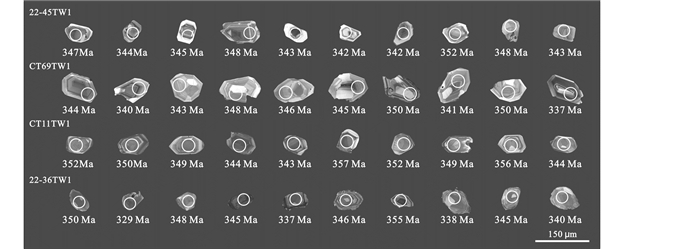
|
图 6 下二台地区变质火山岩典型锆石阴极发光(CL)图像 Fig. 6 The cathodoluminescence (CL) image of typical zircons from the meta-volcanic rocks in the Xia'ertai area |

|
图 7 下二台地区变质火山岩锆石U-Pb年龄谐和图和加权平均年龄 Fig. 7 Zircon U-Pb age concordia diagrams and weighted average age of the meta-volcanic rocks in the Xia'ertai area |
样品CT69TW1中锆石呈自形柱状,长径80~120μm,长宽比1:1~2:1,其具有明显的振带环带结构(图 6),Th/U比值为0.89~2.42,具有典型岩浆锆石特征,部分锆石见很窄的白色亮边,说明存在微弱的重结晶。锆石测点中26个测点的同位素年龄集中落在谐和线上及其附近,锆石测点206Pb/238U年龄介于327~357Ma之间,加权平均值为341±3Ma(MSWD=0.89)(图 7b)。
样品CT11TW1中锆石呈自形柱状,长径50~100μm,长宽比1:1~2:1,其具有明显的振带环带结构(图 6),Th/U比值为0.73~2.20,具有典型岩浆锆石特征,部分锆石见很窄的白色亮边,说明存在微弱的重结晶。锆石测点中17个测点的同位素年龄集中落在谐和线上及其附近,锆石测点206Pb/238U年龄介于342~357Ma之间,加权平均值为348±3Ma(MSWD=0.62)(图 7c)。
样品22-36TW1中的锆石呈自形柱状,长径40~80μm,长宽比1.5:1~2:1,其具有明显的振带环带结构(图 6),Th/U比值为0.80~2.43,具有典型岩浆锆石特征。锆石测点中23个测点的同位素年龄集中落在谐和线上及其附近,其中,锆石测点206Pb/238U年龄介于325~358Ma之间,加权平均值为341±4Ma(MSWD=1.7)(图 7d)。
4 讨论 4.1 形成时代“下二台岩群”最初被认为是一套正常沉积序列地层,形成时代为奥陶纪(王东方, 1987; 矿产局, 1989; 辽宁省地质矿产勘查局第九地质大队, 2000);沈阳地质矿产研究所(2006)在原下二台群划分的黄顶子组中发现了海百合茎化石,又将“下二台岩群”时代定为石炭纪;近年来,随着锆石U-Pb同位素精确定年技术的发展,新的年龄证据又被提出,Wang et al. (2015)报道了盘岭岩组变流纹岩和变玄武安山岩原岩年龄为342Ma和347Ma,韩作振等(2016)报道下二台群盘岭组角闪变粒岩原岩年龄为348±5Ma,时代均为早石炭世。本文中下二台地区变质火山岩锆石具有岩浆锆石特征,代表了变质火山岩原岩结晶年龄,其中变流纹岩206Pb/238U加权平均年龄为341±3Ma和347±3Ma,绿帘黑云母二长微晶片岩206Pb/238U加权平均年龄为348±3Ma,角闪斜长片麻岩206Pb/238U加权平均年龄为341±4Ma,均表明下二台地区变质火山岩原岩形成于早石炭世。
4.2 岩石成因与源区性质岩石在变质或变形过程中会发生元素的迁移。下二台地区变质火山岩样品中K2O、Ba含量变化较大,表明在变质过程中元素发生了迁移;烧失量(LOI)的值为0.86~2.15,δCe为0.87~0.99,表明其遭受了较弱的蚀变作用;然而,蚀变作用对稀土元素和高场强元素含量的影响较小(Polat et al., 2002),因此,我们采用这些元素来判别岩石成因更为可靠。
野外地质观察发现,下二台地区变质酸性火山岩产出面积多于变质中性火山岩(图 2);变质火山岩稀土元素配分曲线都具有右倾特征,且负Eu异常不明显(图 5a),但变质中性火山岩稀土总量明显偏低;在微量元素蛛网图中(图 5b),变质酸性火山岩与变质中性火山岩具有明显差异,主要体现在变质酸性火山岩明显的Sr、P元素亏损,这些元素在岩石变质过程中几乎不发生迁移,可见,两者原岩为不同来源岩浆演化的产物;于此同时,哈克图解也未显示二者高场强元素之间有规律性的线性变化关系,也表明变质酸性火山岩与变质中性火山岩原岩不是同一基性岩浆分异的产物。
变质酸性火山岩虽然具有高SiO2、高K2O+Na2O的特征,但其低FeOT/MgO比值(2.74~5.75,平均3.85),低10000×Ga/Al比值(2.09~2.35,平均2.23),较低含量Zr、Nb、Ce和Y的特点,都与典型的A型花岗岩不同(Whalen et al., 1987),全岩锆饱和温度计公式计算得出变质酸性火山岩饱和温度TZr=776~813℃,平均值为801℃,也与A型花岗岩高温(>900℃),贫水(< 4%)的特点相悖(Clemens et al., 1986),在Nb-10000×Ga/Al图解(图 8a)中,样品也落在了I型和S型花岗岩区域中;低A/CNK值(0.91~1.06,平均0.98),低P2O5含量(0.07~0.22,平均0.13)的特点,且P2O5-SiO2哈克图解(图 8b)中,SiO2与P2O5呈负相关特征,又表明其与S型花岗岩特征不同(Chappell, 1999);综上认为下二台地区变质酸性火山岩原岩岩石类型应与I型花岗岩相似。
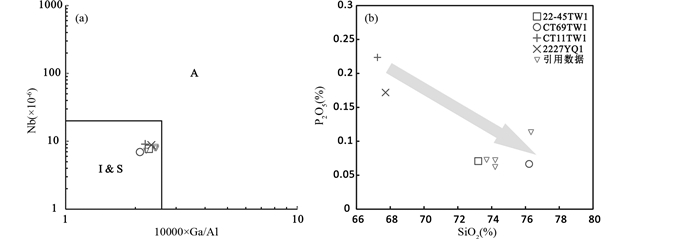
|
图 8 下二台地区变质火山岩Nb-10000×Ga/Al图解(a, 据Whalen et al., 1987)和P2O5-SiO2哈克图解(b) 引用数据来自Wang et al., 2015 Fig. 8 Nb vs. 10000×Ga/Al diagram (a, after Whalen et al., 1987) and P2O5 vs. SiO2 Harker diagram (b) of the meta-volcanic rocks in the Xia'ertai area Reference data from Wang et al., 2015 |
变质酸性火山岩具有高SiO2、高K2O+Na2O含量,低MgO、TiO2和FeOT含量的特点,这与平均大陆地壳化学成分(Rudnick and Gao, 2003)相似,而明显区别于地幔岩石的化学成分(Sun and McDonough, 1989);在K2O-SiO2图解(图 4c)中,样品落在了钙碱性系列和钾玄岩系列中,岩石较高的K2O含量,普遍被理解为在部分熔融的过程中,受控于源区较高的钾含量(Gunnarsson et al., 1998);微量元素方面,Zr、Hf元素的显著富集和Nb元素的显著亏损也表明其原始岩浆与壳源岩浆一致(Rudnick and Gao, 2003; Sun and McDonough, 1989);La/Yb比值为4.99~9.93,平均值6.67,明显不同于地幔来源的岩浆(La/Yb≈0.96)(肖庆辉等, 2002);变质酸性火山岩Mg#值为23.66~39.45,小于45,表明岩浆母岩未与地幔相互作用(程银行等, 2016);以上均表明,变质酸性火山岩原始岩浆可能来源于富集地壳物质的部分熔融。
变质中性火山岩具有较高Al2O3含量(>15%),低MgO含量(< 5%),FeOT/MgO比值2.80~3.31(>1.5),富集Rb、Th、U和K等大离子亲石元素,亏损Nb、P、Ti等高场强元素,这些特征表明其原岩具有岛弧火山岩的特征。样品SiO2含量57.50%~57.68%,显示出幔源岩石的成分特征;Nb/Ta比值为16.02(21-35YQ1除外),Zr/Hf比值为34.5~36.2,明显接近MORB的相应比值(17.5和36.25)(Green, 1995; Sun and McDonough, 1989),而与大陆地壳的相应比值(11~12和18.75)(Green, 1995; Taylor and McLennan, 1985)不同,暗示其岩浆起源于地幔源区;变质中性火山岩的微量元素以富集大离子亲石元素和轻稀土元素,相对亏损高场强元素为特征,表明其起源于岩石圈地幔(Sklyarov et al., 2003; Zhao and Zhou, 2007);在Nb/Y-Zr/Y图解(图 9a)中显示出其原始岩浆应该来自于岩石圈地幔。变质中性火山岩(Th/Ta)PM比值为1.28~3.98(>1),(La/Nb)PM比值为2.86~4.79(>1),La/Sm与La/Nb比值的正相关性,均表明其岩浆物质在上升过程中遭受了地壳物质的混染作用,但其La/Nb值为2.75~4.62,远低于典型地壳岩石(>12),表明地壳物质的混染作用不明显。La/Sm比值和La含量变化趋势表明微量元素的变化主要受控于部分熔融,结晶分异作用较弱,具体表现为Eu的弱负异常。Nb、Ti元素的明显负异常,被视为俯冲带岩浆作用的典型标志(Briqueu et al., 1984);在Rb/Y-Nb/Y图解(图 9b)中,样品主要沿Rb/Y轴分布,具有俯冲带富集或混染的趋势,证明该岩浆形成于与俯冲消减作用有关的地幔源区。综上所述,变质中性火山岩原始岩浆来自于俯冲带附近岩石圈地幔,并遭受了地壳物质的混染。
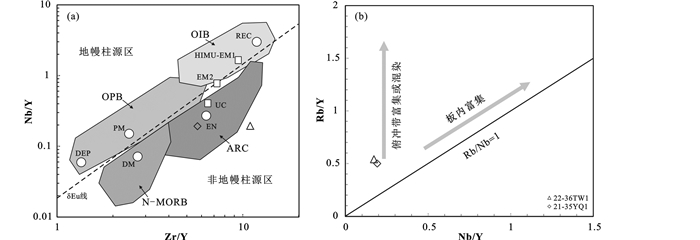
|
图 9 下二台地区变质火山岩Nb/Y-Zr/Y图解(a, 据Condie, 2005)和Rb/Y-Nb/Y图解(b, 据Deng et al., 2019) Fig. 9 Nb/Y vs. Zr/Y diagram (a, after Condie, 2005) and Rb/Y vs. Nb/Y diagram (b, after Deng et al., 2019) of the meta-volcanic rocks in the Xia'ertai area |
Wang et al. (2015)报道下二台地区变流纹岩与变玄武安山岩形成于伸展构造背景下,具有双峰式火山岩的特征;韩作振等(2016)报道下二台地区角闪变粒岩为一套弧火山岩,形成于活动大陆边缘;二者所研究的变质火山岩时代都为早石炭世,且均位于下二台地区盘岭背形上,但构造背景却不同。本次研究的下二台地区变质火山岩原岩形成时代也为早石炭世,结合前人研究成果,该套变质火山岩原岩岩石类型包括流纹岩、英安岩、安山岩和玄武安山岩,与活动大陆边缘弧环境下形成的岩石组合特征一致,不属于双峰式火山岩岩石组合。
下二台地区变质酸性火山岩原岩岩石类型与I型花岗岩相似,可能来源于富集地壳物质的部分熔融;变质中性火山岩原岩具有弧火山岩的特征,原始岩浆来自于俯冲带附近岩石圈地幔,并遭受了地壳物质的混染,这些均表明下二台地区变质火山岩原岩的形成与俯冲作用有关。结合下二台地区已发表的变质火山岩地球化学数据(Wang et al., 2015; 韩作振等, 2016),我们对下二台地区变质火山岩进行了构造环境判别,Y/15-La/10-Nb/8图解(图 10a)、Hf/3-Th-Nb/16图解(图 10b)和2Nb-Zr/4-Y图解(图 10c)均表明下二台地区变质火山岩原岩应形成于火山弧环境,在Th/Yb-Nb/Yb图解(图 10d)中,所有样品落入大陆边缘弧环境中,因此,我们认为下二台地区变质火山岩原岩应形成于活动大陆边缘火山弧环境。
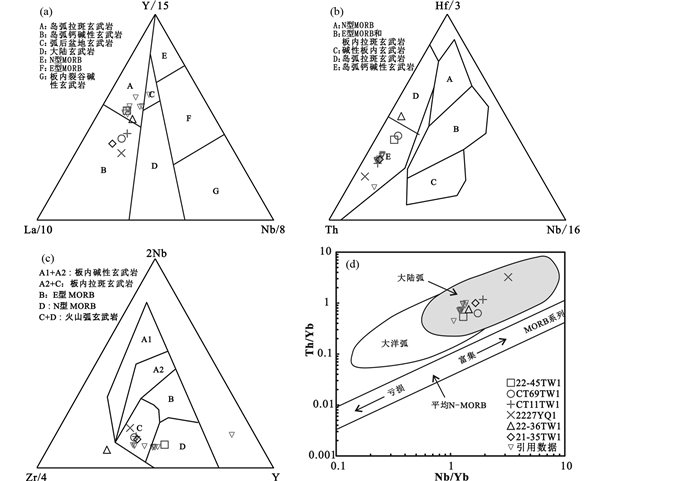
|
图 10 下二台地区变质火山岩构造环境判别图解 (a)Y/15-La/10-Nb/8图解(据Cabanis and Lecolle, 1989);(b)Hf/3-Th-Nb/16图解(据Wood, 1980);(c)2Nb-Zr/4-Y图解(据Meschede, 1986);(d)Th/Yb-Nb/Yb图解(据Pearce and Peate, 1995).引用数据来自Wang et al., 2015; 韩作振等, 2016 Fig. 10 Tectonic environment discriminant diagrams of the meta-volcanic rocks in the Xia'ertai area (a) Y/15-La/10-Nb/8 diagram (after Cabanis and Lecolle, 1989); (b) Hf/3-Th-Nb/16 diagram (after Wood, 1980); (c) 2Nb-Zr/4-Y diagram (after Meschede, 1986) and (d) Th/Yb vs. Nb/Yb diagram (after Pearce and Peate, 1995). Reference data from Wang et al., 2015; Han et al., 2016 |
华北板块北缘东段相继识别出“开原”、“呼兰群”、“色洛河群”、“开山屯”和“青龙村群”等几套构造混杂岩(图 11),众多学者已经做了大量工作(唐克东等, 2004, 2011; 陈跃军等, 2006; 李承东等, 2007a, b; 唐克东和赵爱林, 2007; Wu et al., 2007; 张春艳等, 2007, 2009; Lü et al., 2011;周建波等, 2013; 张超, 2014; Yuan et al., 2016; Liu et al., 2017a; 关庆彬, 2018)。“开原”构造混杂岩“岩块”中变质流纹岩和变质玄武安山岩的形成年龄为250±5Ma和250±4Ma(陈跃军等, 2006; Yuan et al., 2016),变质基性岩原岩的形成年龄为258±6Ma、变质年龄为256±4Ma(关庆彬, 2018),“基质”中透辉变粒岩碎屑锆石最小年龄为257±2Ma,变质年龄为245±2Ma(Liu et al., 2017a),表明该套构造混杂岩形成于晚二叠世-早三叠世。“呼兰群”构造混杂岩中大量片岩的碎屑锆石年龄将其时代归属为二叠纪-早三叠世(Wu et al., 2007; Lü et al., 2011;周建波等, 2013);张春艳等(2009)测得磐石地区硅质岩的变质变形年龄为239±11Ma,为古亚洲洋闭合过程的产物。“色洛河群”构造混杂岩中高镁安山岩成岩年龄为252±5Ma(李承东等, 2007a),周建波等(2013)测得板庙子地区“色洛河群”砂岩和板岩的碎屑锆石年龄为255±3Ma和264±3Ma,表明“色洛河群”可能形成于晚二叠世。“开山屯”混杂岩被认为是一套由滑塌堆积、浊积岩以及深海泥质岩组成的大陆边缘的增生杂岩(唐克东等, 2004, 2011);唐克东和赵爱林(2007)报道了杂岩中花岗岩砾石的年龄为287±6Ma,周建波等(2013)报道了“开山屯”杂岩中紫色板岩和变质砂岩碎屑锆石沉积下限年龄为234Ma和246Ma,时代为中-晚三叠世。“青龙村群”中获得的斜长角闪岩、黑云斜长片麻岩和变质辉长岩的原岩年龄分别为274±6Ma、250±4Ma和248±1Ma(张春艳等, 2007; 周建波等, 2013)。张超(2014)将新东村组地层从“青龙村群”中划分出来,并测得二云母片岩碎屑锆石年龄集中在242~314Ma之间,同样给出了中三叠世的沉积下限年龄。这些研究表明前人划定元古代地层,如“呼兰群”、“色洛河群”、“青龙村群”都不是真正的地层序列,而是由不同时代、不同性质的岩石混杂形成(唐克东等, 2004; 周建波等, 2013),而将这些杂岩解体后,其中年轻的地质体多形成于晚二叠世-中三叠世。
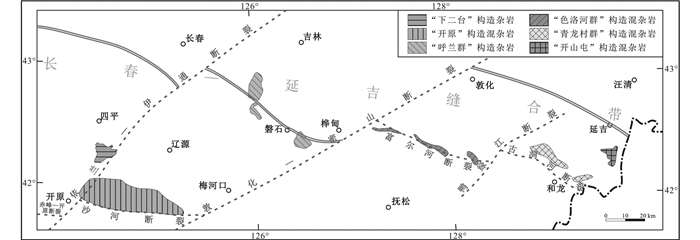
|
图 11 华北板块北缘东段构造混杂岩分布图(据关庆彬, 2018) Fig. 11 Tectonic melange distribution map of eastern segment of the northern margin of the North China Block (after Guan, 2018) |
“下二台岩群”同已报道的构造混杂岩同处于华北板块北缘东段增生带内,下二台地区变质火山岩原岩形成时代为早石炭世,为活动大陆边缘环境下形成的弧火山岩;区内还大面积分布大理岩,根据牙形刺化石初步确定其时代为晚石炭世(作者,待发表),由大洋底-大陆边缘之间海相环境下形成的碳酸盐岩变质而成;我们还获得二云母二长变粒岩碎屑锆石年龄为384~443Ma(作者,待发表),沉积下限时代为中泥盆世,原岩为稳定环境下形成的陆源碎屑岩;同时,中二叠世变质酸性火山岩也被识别出,具有弧火山岩特征。结合野外地质产出状态,各地质体受构造作用改造强烈,变质变形作用发育,总体构造行迹呈北东向展布,不同时代的地质单元间多为构造接触。由此可见,原“下二台岩群”的物质组成存在多时代特征,且均为不同构造环境下形成的产物,再遭受后期构造作用改造,叠置混杂在一起,因此,“下二台岩群”并不是传统的史密斯地层层序,将其定义为“下二台”构造杂岩更为准确。
大量的蛇绿岩、岩相古地理学和古生物学证据基本确定了古亚洲洋最终沿着索伦山-西拉木伦河-长春-延吉缝合带呈“剪刀式”闭合(Wu et al., 2000, 2007, 2011; Xiao et al., 2003, 2009, 2015; 孙德有等, 2004; Li, 2006;张兴洲等, 2006; Jian et al., 2008, 2010; 韩国卿等, 2009, 2011; 刘永江等, 2010, 2011; Han et al., 2012, 2015; Xu et al., 2015; Liu et al., 2017b)。在该缝合带西段,古亚洲洋板块具有双向俯冲的特征(Xiao et al., 2003; Jian et al., 2008, 2010);部分学者通过对苏尼特右旗白乃庙群变质火山岩研究,提出古亚洲洋板块在晚寒武世-早志留世持续南向俯冲(Gu et al., 2012; Zhang et al., 2013; Li et al., 2015; Zhou et al., 2017),并在华北板块北缘形成一系列与俯冲碰撞有关的埃达克质岩石和TTG岩石(刘敦一等, 2003; Jian et al., 2008; Zhang et al., 2019);中-晚志留世,白乃庙地区出现了东西向展布的前陆盆地,复理石建造和磨拉石建造就位,标志着俯冲作用的结束(胡骁等, 1990; 唐克东, 1992)。在该缝合带东段,Pei et al. (2016)通过对吉林省中部古生代火成岩和变质沉积岩研究,提出古亚洲洋在早寒武世-早志留世持续向北俯冲,晚志留世-早泥盆世发生弧-陆碰撞,进入后碰撞阶段;唐克东和赵爱林(2007)在对开山屯地区混杂岩进行研究后,提出晚石炭世-中二叠世古亚洲洋洋壳向北运移,并向北部兴凯地块俯冲。下二台地区变质火山岩为古亚洲洋板块在该缝合带东段向华北板块俯冲提供了依据,可见,古亚洲洋板块在该缝合带东段也具有双向俯冲模式。由于华北板块北缘尚未发现大量志留纪-泥盆纪期间岩浆岩的相关地质记录,有些学者推测华北板块北缘在这一时期可能属于被动大陆边缘环境(李锦轶等, 2009),但是,双向俯冲这一观点已被许多学者所证实(Jia et al., 2004; 曹花花等, 2012; Yuan et al., 2016; 关庆彬, 2018);多数观点认为该缝合带东段俯冲作用主要发生在早二叠世-早三叠世(李承东等, 2007a; 曹花花等, 2012; Yuan et al., 2016; 关庆彬, 2018);下二台地区变质火山岩表明在早石炭世该缝合带东段古亚洲洋板块就已经南向俯冲。Shi et al. (2019)报道法库地区石英闪长岩与花岗闪长岩侵位结晶年龄为432±1Ma和437±1Ma,为一套与俯冲作用有关的埃达克质岩石,表明早志留世索伦-西拉木伦河-长春-延吉缝合带东段古亚洲洋板块向华北板块俯冲,这与该缝合带西段具有相似特征。
综上所述,中泥盆世,华北板块北缘东段可能处于被动大陆边缘环境,中泥盆世变质陆源碎屑岩原岩为该环境下的产物,华北板块北缘东段早志留世花岗质岩石为其提供物源;晚泥盆世-早石炭世,华北板块北缘东段古亚洲洋板块向华北板块俯冲,俯冲洋壳导致岩石圈地幔发生熔融,形成变质中性火山岩原始岩浆,在其上升过程中,又遭受地壳物质混染,最终形成早石炭世中性火山岩;地幔物质带来的热量导致地壳物质发生部分熔融,为早石炭世变质酸性火山岩提供物质来源(图 12);晚石炭世变质碳酸盐岩和中二叠世变质酸性火山岩的出现,表明洋盆并没有消失,俯冲作用仍在持续;晚二叠世-中三叠世,古亚洲洋最终闭合(崔军平等, 2013; 徐增连等, 2014)。

|
图 12 中泥盆世-早石炭世古亚洲洋南向俯冲演化模式图 Fig. 12 Schematic model showing the tectonic evolution of the Paleo-Asian Ocean subducted southward in Middle Devonian-Early Carboniferous |
(1) 下二台地区变质火山岩原岩包括流纹岩、英安岩、安山岩,为一套钙碱性火山岩,属于准铝质-弱过铝质岩石,根据岩相学和地球化学特征将其分为变质酸性火山岩和变质中性火山岩;二者均相对富集轻稀土元素,亏损重稀土元素,轻重稀土元素分馏明显,Eu负异常不明显,但变质中性火山岩稀土总量低于变质酸性火山岩,而且变质酸性火山岩明显亏损Sr、P元素,结合野外产状面积和高场强元素相关性特征,认为二者不是同一基性岩浆分异的产物。
(2) 下二台地区变质火山岩锆石具有岩浆锆石特征,代表了原岩结晶年龄,变质酸性火山岩(变流纹岩、绿帘黑云母二长微晶片岩)原岩结晶年龄为341±3Ma、347±3Ma和348±3Ma,变质中性火山岩(角闪斜长片麻岩)原岩结晶年龄为341±4Ma,时代均为早石炭世;变质酸性火山岩原始岩浆来自于地壳物质的部分熔融,变质中性火山岩原始岩浆来自于俯冲带附近岩石圈地幔,并遭受了地壳物质的混染,二者均形成于活动大陆边缘火山弧环境。
(3) 原“下二台岩群”并不是真正的地层层序,称其为“下二台”构造杂岩更为准确;下二台地区变质火山岩表明在早石炭世初,古亚洲洋板块已经开始南向俯冲,在华北板块北缘东段形成活动大陆边缘弧环境,早石炭世变质火山岩原岩为这一俯冲阶段的产物。
致谢 感谢中国科学院海洋研究所大洋岩石圈与地幔动力学超净实验室王晓红和自然资源部东北亚矿产资源评价重点实验室郝宇杰在锆石U-Pb同位素测年过程中给予的帮助;感谢自然资源部东北矿产资源监督检测中心赵爱林、钟辉、王洋洋、刘欣和伍月在试验测试和薄片鉴定方面给予的帮助;感谢匿名审稿专家和本刊编辑对本文提出的建设性修改意见。
谨以此文祝贺杨振升教授九十华诞,祝杨先生健康长寿!
Briqueu L, Bougault H and Joron JL. 1984. Quantification of Nb, Ta, Ti and V anomalies in magmas associated with subduction zones:Petrogenetic implications. Earth and Planetary Science Letters, 68(2): 297-308 |
Bureau of Geology and Mineral Resources of Liaoning Province. 1989. Regional Geology of Liaoning Province. Beijing: Geological Publishing House (in Chinese)
|
Cabanis B and Lecolle M. 1989. Le diagramme La/10-Y/15-Nb/8:Un outil pour la discrimination des series volcaniques et la mise en evidence des processus de melange et/ou de contamination crustale. Compte Rendus de I'Académie des Sciences Series Ⅱ, 309: 2023-2029 |
Cao HH, Xu WL, Pei FP, Guo PY and Wang F. 2012. Permian tectonic evolution of the eastern section of the northern margin of the North China Plate:Constraints from zircon U-Pb geochronology and geochemistry of the volcanic rocks. Acta Petrologica Sinica, 28(9): 2733-2750 (in Chinese with English abstract) |
Chappell BW. 1999. Aluminium saturation in I- and S-type granites and the characterization of fractionated haplogranites. Lithos, 46(3): 535-551 DOI:10.1016/S0024-4937(98)00086-3 |
Chen YJ, Peng YQ, Liu YW, Sun G and Matthew G. 2006. Progress in the study of Chronostratigraphy of the "Qinghezhen Group". Geological Review, 52(2): 170-177 (in Chinese with English abstract) |
Cheng YH, Li Y, Liu YS, Teng XJ, Li YF, Yang JQ and Ao C. 2016. The tectonic extensional event during the early cretaceous in the west margin of Songliao Basin:U-Pb dating, geochemistry and petrogenesis of rhyolites. Acta Geologica Sinica, 90(12): 3492-3507 (in Chinese with English abstract) |
Clemens JD, Holloway JR and White AJR. 1986. Origin of an A-type granite:Experimental constraints. American Mineralogist, 71(3-4): 317-324 |
Condie KC. 2005. High field strength element ratios in Archean basalts:A window to evolving sources of mantle plumes?. Lithos, 79(3-4): 491-504 DOI:10.1016/j.lithos.2004.09.014 |
Cui JP, Ren ZL, Shi Z, Li JX and Wang WQ. 2013. Analysis on Permian depositional characteristics and proto-type basin of Northeast China. Geoscience, 27(2): 260-268 (in Chinese with English abstract) |
Deng CZ, Sun DY, Li GH, Lu S, Tang ZY, Gou J and Yang YJ. 2019. Early Cretaceous volcanic rocks in the Great Xing'an Range:Late effect of a flat-slab subduction. Journal of Geodynamics, 124: 38-51 DOI:10.1016/j.jog.2019.01.012 |
Ge WC, Wu FY, Zhou CY and Zhang JH. 2005. Zircon U-Pb ages and its significance of the Mesozoic granites in the Wulanhaote region, central Da Hinggan Mountain. Acta Petrologica Sinica, 21(3): 749-762 (in Chinese with English abstract) |
Green TH. 1995. Significance of Nb/Ta as an indicator of geochemical processes in the crust-mantle system. Chemical Geology, 120(3-4): 347-359 DOI:10.1016/0009-2541(94)00145-X |
Gu C, Zhou ZA, Zhang WK, Liu CF, Liu WC and Wu YS. 2012. Zircon dating of the Baiyinduxi Group in Inner Mongolia and its tectonic interpretation. Geoscience, 26(1): 1-9 |
Guan QB. 2018. Permian-Early Jurassic tectonic evolution of Kaiyuan-Yanji area in the eastern segment of the northern margin of the North China Block. Ph. D. Dissertation. Changchun: Jilin University (in Chinese)
|
Gunnarsson B, Marsh BD and Taylor HP Jr. 1998. Generation of Icelandic rhyolites:Silicic lavas from the Torfajökull central volcano. Journal of Volcanology and Geothermal Research, 83(1-2): 1-45 DOI:10.1016/S0377-0273(98)00017-1 |
Han GQ, Liu YJ, Jin W, Wen QB, Li W, Liang CY and Liang DJ. 2009. The distribution of Xar Moron River Fault under Songliao Basin. Geology in China, 36(5): 1010-1020 (in Chinese with English abstract) |
Han GQ, Liu YJ, Wen QB, Li W, Wu LN, Zhao YL, Ding L, Zhao LM and Liang CY. 2011. LA-ICP-MS U-Pb dating of detrital zircons from the Permian sandstones in north side of Xar Moron River Suture Belt and its tectonic implications. Earth Science (Journal of China University of Geosciences), 36(4): 687-702 (in Chinese with English abstract) |
Han GQ, Liu YJ, Neubauer F, Genser J, Zhao YL, Wen QB, Li WM, Wu LN, Jiang XY and Zhao LM. 2012. Provenance analysis of Permian sandstones in the central and southern Da Xing'an Mountains, China:Constraints on the evolution of the eastern segment of the Central Asian Orogenic Belt. Tectonophysics, 580: 100-113 DOI:10.1016/j.tecto.2012.08.041 |
Han GQ, Liu YJ, Neubauer F, Bartel E, Genser J, Feng ZQ, Zhang L and Yang MC. 2015. U-Pb age and Hf isotopic data of detrital zircons from the Devonian and Carboniferous sandstones in Yimin area, NE China:New evidences to the collision timing between the Xing'an and Erguna blocks in eastern segment of Central Asian Orogenic Belt. Journal of Asian Earth Sciences, 97: 211-228 DOI:10.1016/j.jseaes.2014.08.006 |
Han ZZ, Guo ZP, Gao LH, Song ZG, Han M, Liu GY, Zhong WJ, Li JJ and Yan JL. 2016. Geochronology and geochemistry characteristics of volcanic rocks from Panling Formation of Xiaertai Group in Changtu Area, Liaoning Province. Journal of Shandong University of Science and Technology, 35(5): 1-8 (in Chinese with English abstract) |
Hu X, Xu CS and Niu SY. 1990. Evolution of the Early Paleozoic Continental Margin in Northern Margin of the North China Platform. Beijing: Peking University Press (in Chinese)
|
Jia DC, Hu RZ, Lu Y and Qin XL. 2004. Collision belt between the Khanka block and the North China block in the Yanbian Region, Northeast China. Journal of Asian Earth Sciences, 23(2): 211-219 DOI:10.1016/S1367-9120(03)00123-8 |
Jian P, Liu DY, Kröner A, Windley BF, Shi YR, Zhang FQ, Shi GH, Miao LC, Zhang W, Zhang Q, Zhang LQ and Ren JS. 2008. Time scale of an early to mid-Paleozoic orogenic cycle of the long-lived Central Asian Orogenic Belt, Inner Mongolia of China:Implications for continental growth. Lithos, 101(3-4): 233-259 DOI:10.1016/j.lithos.2007.07.005 |
Jian P, Liu DY, Kröner A, Windley BF, Shi YR, Zhang W, Zhang FQ, Miao LC, Zhang LQ and Tomurhuu D. 2010. Evolution of a Permian intraoceanic arc-trench system in the Solonker suture zone, Central Asian Orogenic Belt, China and Mongolia. Lithos, 118(1-2): 169-190 DOI:10.1016/j.lithos.2010.04.014 |
Le Maitre RW. 1989. A Classification of Igneous Rocks and Glossary of Terms. Oxford: Blackwell Scientific Publications, 1-193
|
Li CD, Zhang FQ, Miao LC, Jie HQ and Xu YW. 2007a. Zircon SHRIMP geochronology and geochemistry of Late Permian high-Mg andesites in Seluohe area, Jilin Province, China. Acta Petrologica Sinica, 23(4): 767-776 (in Chinese with English abstract) |
Li CD, Zhang FQ, Miao LC, Xie HQ, Hua YQ and Xu YW. 2007b. Reconsideration of the Seluohe Group in Seluohe Area, Jilin Province. Journal of Jilin University (Earth Science Edition), 37(5): 841-847 (in Chinese with English abstract) |
Li JY. 2006. Permian geodynamic setting of Northeast China and adjacent regions:Closure of the Paleo-Asian Ocean and subduction of the Paleo-Pacific Plate. Journal of Asian Earth Sciences, 26(3-4): 207-224 DOI:10.1016/j.jseaes.2005.09.001 |
Li JY, Zhang J, Yang TN, Li YP, Sun GH, Zhu ZX and Wang LJ. 2009. Crustal tectonic division and evolution of the southern part of the North Asian Orogenic Region and its adjacent areas. Journal of Jilin University (Earth Science Edition), 39(4): 584-605 (in Chinese with English abstract) |
Li S, Wilde SA, He ZJ, Jiang XJ, Liu RY and Zhao L. 2014. Triassic sedimentation and post accretionary crustal evolution along the Solonker suture zone in Inner Mongolia, China. Tectonics, 33(6): 960-981 DOI:10.1002/2013TC003444 |
Li S, Chung SL, Wilde SA, Jahn BM, Xiao WJ, Wang T and Guo QQ. 2017. Early-Middle Triassic high Sr/Y granitoids in the southern Central Asian Orogenic Belt:Implications for ocean closure in accretionary orogens. Journal of Geophysical Research:Solid Earth, 122(3): 2291-2309 |
Li WB, Hu CS, Zhong RC and Zhu F. 2015. U-Pb, 39Ar/40Ar geochronology of the metamorphosed volcanic rocks of the Bainaimiao Group in central Inner Mongolia and its implications for ore genesis and geodynamic setting. Journal of Asian Earth Sciences, 97: 251-259 DOI:10.1016/j.jseaes.2014.06.007 |
Liu DY, Jian P, Zhang Q, Zhang FQ, Shi YR, Shi GH, Zhang LQ and Tao H. 2003. SHRIMP dating of adakites in the Tulingkai ophiolite, Inner Mongolia:Evidence for the Early Paleozoic Subduction. Acta Geologica Sinica, 77(3): 317-327 (in Chinese with English abstract) |
Liu J, Liu ZH, Zhao C, Wang CJ, Guan QB, Dou SY and Song SE. 2017a. Geochemistry and U-Pb detrital zircon ages of Late Permian to Early Triassic metamorphic rocks from northern Liaoning, North China:Evidence for the timing of final closure of the Paleo-Asian Ocean. Journal of Asian Earth Sciences, 145: 460-474 DOI:10.1016/j.jseaes.2017.06.026 |
Liu YJ, Zhang XZ, Jin W, Chi XG, Wang CW, Ma ZH, Han GQ, Wen QB, Zhao YL, Wang WD and Zhao XF. 2010. Late Paleozoic tectonic evolution in Northeast China. Geology in China, 37(4): 943-951 (in Chinese with English abstract) |
Liu YJ, Zhang XZ, Chi XG, Wen QB, Liang CY, Han GQ, Zhao LM and Zhao YL. 2011. Deformation and tectonic layer division of the Upper Paleozoic in Daxing'anling area. Journal of Jilin University (Earth Science Edition), 41(5): 1304-1310 (in Chinese with English abstract) |
Liu YJ, Li WM, Feng ZQ, Wen QB, Neubauer F and Liang CY. 2017b. A review of the Paleozoic tectonics in the eastern part of Central Asian Orogenic Belt. Gondwana Research, 43: 123-148 DOI:10.1016/j.gr.2016.03.013 |
Liu YJ, Feng ZQ, Jiang LW, Jin W, Li WM, Guan QB, Wen WB and Liang CY. 2019. Ophiolite in the eastern Central Asian Orogenic Belt, NE China. Acta Petrologica Sinica, 35(10): 3017-3047 (in Chinese with English abstract) DOI:10.18654/1000-0569/2019.10.05 |
Liu YS, Gao S, Hu ZC, Gao CG, Zong KQ and Wang DB. 2010. Continental and oceanic crust recycling-induced melt-peridotite interactions in the Trans-North China Orogen:U-Pb dating, Hf isotopes and trace elements in zircons from mantle xenoliths. Journal of Petrology, 51(1-2): 537-571 DOI:10.1093/petrology/egp082 |
Lü LS, Mao JW, Li HB, Pirajno F, Zhang ZH and Zhou ZH. 2011. Pyrrhotite Re-Os and SHRIMP zircon U-Pb dating of the Hongqiling Ni-Cu sulfide deposits in Northeast China. Ore Geology Reviews, 43(1): 106-119 DOI:10.1016/j.oregeorev.2011.02.003 |
Ludwig KR. 2003. Isoplot 3.00: A Geochronological Toolkit for Microsoft Excel. California, Berkeley: Berkeley Geochronology Center
|
Maniar PD and Piccoli PM. 1989. Tectonic discrimination of granitoids. GSA Bulletin, 101(5): 635-643 DOI:10.1130/0016-7606(1989)101<0635:TDOG>2.3.CO;2 |
Meschede M. 1986. A method of discriminating between different types of mid-ocean ridge basalts and continental tholeiites with the Nb-Zr-Y diagram. Chemical Geology, 56(3-4): 207-218 DOI:10.1016/0009-2541(86)90004-5 |
Pearce JA and Peate DW. 1995. Tectonic implications of the composition of volcanic ARC magmas. Annual Review of Earth and Planetary Sciences, 23: 251-285 DOI:10.1146/annurev.ea.23.050195.001343 |
Peccerillo A and Taylor SR. 1976. Geochemistry of Eocene calc-alkaline volcanic rocks from the Kastamonu Area, Northern Turkey. Contributions to Mineralogy and Petrology, 58: 63-81 DOI:10.1007/BF00384745 |
Pei FP, Zhang Y, Wang ZW, Cao HH, Xu XL, Wang ZJ, Wang F and Yang C. 2016. Early-Middle Paleozoic subduction-collision history of the south-eastern Central Asian Orogenic Belt:Evidence from igneous and metasedimentary rocks of central Jilin Province, NE China. Lithos, 261: 164-180 DOI:10.1016/j.lithos.2015.12.010 |
Polat A, Hofmann AW and Rosing MT. 2002. Boninite-like volcanic rocks in the 3.7~3.8Ga Isua greenstone belt, West Greenland:Geochemical evidence for intra-oceanic subduction zone processes in the early Earth. Chemical Geology, 184(3-4): 231-254 DOI:10.1016/S0009-2541(01)00363-1 |
Ren JS. 1991. The basic characteristics of the tectonic evolution of the continental lithosphere in China. Regional Geology of China, (4): 289-293 (in Chinese with English abstract) |
Rudnick RL and Gao S. 2003. Composition of the continental crust. In: Rudnick RL (ed.). The Crust. Oxford: Elsevier, 3: 1-64
|
Shi Y, Shi SS, Liu ZH, Liu J, Ju N, You HX, Zhang ZB and Zhao CQ. 2019. Petrogenesis of the late Early Palaeozoic adakitic granitoids in the southern margin of the Songliao Basin, NE China:Implications for the subduction of the Palaeo-Asian Ocean. Geological Journal, 54(6): 3821-3839 DOI:10.1002/gj.3377 |
Sklyarov EV, Gladkochub DP, Mazukabzov AM, Menshagin YV, Watanabe T and Pisarevsky SA. 2003. Neoproterozoic mafic dike swarms of the Sharyzhalgai metamorphic massif, southern Siberian craton. Precambrian Research, 122(1-4): 359-376 DOI:10.1016/S0301-9268(02)00219-X |
Sun DY, Wu FY, Zhang YB and Gao S. 2004. The final closing time of the west Lamulun River-Changchun-Yanji plate suture zone:Evidence from the Dayushan granitic pluton, Jilin Province. Journal of Jilin University (Earth Science Edition), 34(2): 174-181 (in Chinese with English abstract) |
Sun SS and McDonough WF. 1989. Chemical and isotopic systematics of oceanic basalts: Implications for mantle composition and processes. In: Saunders AD and Norry MJ (eds.). Magmatism in the Ocean Basins. Geological Society, London, Special Publications, 42(1): 313-345
|
Tang KD. 1992. Tectonic Evolution and Minerogenetic Regularities of the Fold Belt along the Northern Margins of Sino-Korean Plate. Beijing: Peking University Press (in Chinese with English abstract)
|
Tang KD, Shao JA, Li JC and Kang Z. 2004. Nature of the Yanbian suture zone and structure of Northeast Asia. Geological Bulletin of China, 23(9): 885-891 (in Chinese with English abstract) |
Tang KD and Zhao AL. 2007. New evidence of Palaeozoic stratigraphy in the Kaishantun area, Yanbian, Jilin. Journal of Stratigraphy, 31(2): 141-150 (in Chinese with English abstract) |
Tang KD, Shao JA and Li YF. 2011. Songnen Massif and its research significance. Earth Science Frontiers, 18(3): 57-65 (in Chinese with English abstract) |
Taylor SR and McLennan SM. 1985. The Continental Crust: Its Composition and Evolution. Oxford: Blackwell, 1-312
|
Wang DF. 1987. On the problems of strata and tectonics of Liaohe and Xiaertaizi groups in northern Liaoning area. Liaoning Geology, (2): 155-164 (in Chinese with English abstract) |
Wang ZW, Pei FP, Xu WL, Cao HH and Wang ZJ. 2015. Geochronology and geochemistry of Late Devonian and Early Carboniferous igneous rocks of central Jilin Province, NE China:Implications for the tectonic evolution of the eastern Central Asian Orogenic Belt. Journal of Asian Earth Sciences, 97: 260-278 DOI:10.1016/j.jseaes.2014.06.028 |
Whalen JB, Currie KL and Chappell BW. 1987. A-type granites:Geochemical characteristics, discrimination and petrogenesis. Contributions to Mineralogy and Petrology, 95(4): 407-419 DOI:10.1007/BF00402202 |
Wilde SA. 2015. Final amalgamation of the Central Asian Orogenic Belt in NE China:Paleo-Asian Ocean closure versus Paleo-Pacific plate subduction:A review of the evidence. Tectonophysics, 662: 345-362 DOI:10.1016/j.tecto.2015.05.006 |
Winchester JA and Floyd PA. 1977. Geochemical discrimination of different magma series and their differentiation products using immobile elements. Chemical Geology, 20: 325-345 DOI:10.1016/0009-2541(77)90057-2 |
Windley BF, Alexeiev D, Xiao WJ, Kröner A and Badarch G. 2007. Tectonic models for accretion of the Central Asian Orogenic belt. Journal of the Geological Society, 164(1): 31-47 DOI:10.1144/0016-76492006-022 |
Wood DA. 1980. The application of a Th-Hf-Ta diagram to problems of tectonomagmatic classification and to establishing the nature of crustal contamination of basaltic lavas of the British Tertiary Volcanic Province. Earth and Planetary Science Letters, 50(1): 11-30 |
Wu FY, Jahn BM, Wilde SM and Sun DY. 2000. Phanerozoic crustal growth:U-Pb and Sr-Nd isotopic evidence from the granites in northeastern China. Tectonophysics, 328(1-2): 89-113 DOI:10.1016/S0040-1951(00)00179-7 |
Wu FY, Zhao GC, Sun DY, Wilde SA and Yang JH. 2007. The Hulan Group:Its role in the evolution of the Central Asian Orogenic Belt of NE China. Journal of Asian Earth Sciences, 30(3-4): 542-556 DOI:10.1016/j.jseaes.2007.01.003 |
Wu FY, Sun DY, Ge WC, Zhang YB, Grant ML, Wilde SA and Jahn BM. 2011. Geochronology of the Phanerozoic granitoids in northeastern China. Journal of Asian Earth Sciences, 41(1): 1-30 |
Xiao QH, Deng JF and Ma DQ, et al. 2002. The Ways of Investigation on Granitoids. Beijing: Geological Publishing House (in Chinese with English abstract)
|
Xiao WJ, Windley BF, Hao J and Zhai MG. 2003. Accretion leading to collision and the Permian Solonker suture, Inner Mongolia, China:Termination of the Central Asian Orogenic Belt. Tectonics, 22(6): 1069 |
Xiao WJ, Zhang LC, Qin KZ, Sun S and Li JL. 2004. Paleozoic accretionary and collisional tectonics of the eastern Tianshan (China):Implications for the continental growth of Central Asia. American Journal of Science, 304(4): 370-395 |
Xiao WJ, Kröner A and Windley BF. 2009. Geodynamic evolution of Central Asia in the Paleozoic and Mesozoic. International Journal of Earth Sciences, 98(6): 1185-1188 DOI:10.1007/s00531-009-0418-4 |
Xiao WJ, Huang BC, Han CM, Sun S and Li JL. 2010. A review of the western part of the Altaids:A key to understanding the architecture of accretionary orogens. Gondwana Research, 18(2-3): 253-273 DOI:10.1016/j.gr.2010.01.007 |
Xiao WJ, Windley BF, Sun S, Li JL, Huang BC, Han CM, Yuan C, Sun M and Chen HL. 2015. A tale of amalgamation of three Permo-Triassic Collage Systems in Central Asia:Oroclines, sutures, and terminal accretion. Annual Review of Earth and Planetary Sciences, 43(1): 477-507 DOI:10.1146/annurev-earth-060614-105254 |
Xu B, Zhao P, Bao QZ, Zhou YH, Wang YY and Luo ZW. 2014. Preliminary study on the pre-Mesozoic tectonic unit division of the Xing-Meng Orogenic Belt (XMOB). Acta Petrologica Sinica, 30(7): 1841-1857 (in Chinese with English abstract) |
Xu B, Zhao P, Wang YY, Liao W, Luo ZW, Bao QZ and Zhou YH. 2015. The pre-Devonian tectonic framework of Xing'an-Mongolia orogenic belt (XMOB) in North China. Journal of Asian Earth Sciences, 97: 183-196 DOI:10.1016/j.jseaes.2014.07.020 |
Xu ZL, Luo MS, Yang WL, Wang CG and Wu NW. 2014. Paleozoic sedimentary basins evolution of Ertix-Xar moron suture. Earth Science (Journal of China University of Geosciences), 23(8): 1099-1118 (in Chinese with English abstract) |
Yarmolyuk VV, Kovach VP, Kozakov IK, Kozlovsky AM, Kotoy AB and Rytsk EY. 2012. Mechanisms of continental crust formation in the Central Asian foldbelt. Geotectonics, 46(4): 251-272 DOI:10.1134/S001685211204005X |
Yuan LL, Zhang XH, Xue FH, Lu YH and Zong KQ. 2016. Late Permian high-Mg andesite and basalt association from northern Liaoning, North China:Insights into the final closure of the Paleo-Asian Ocean and the orogen-craton boundary. Lithos, 258-259: 58-76 DOI:10.1016/j.lithos.2016.04.024 |
Zhang C. 2014. Mesozoic tectonic evolution in the Yanbian area of the eastern segment of the north margin of the North China Plate. Ph. D. Dissertation. Changchun: Jilin University (in Chinese)
|
Zhang C, Quan JY, Liu ZH, Xu ZY, Pang XJ and Zhang YJ. 2019. Geochemical characteristics and geological significance of meta-volcanic rocks of the Bainaimiao Group, Sonid Right Banner, Inner Mongolia, China. Journal of Earth Science, 30(2): 272-285 DOI:10.1007/s12583-018-1202-9 |
Zhang CY, Zhang XZ and Qiu DM. 2007. Zircon U-Pb isotopic ages of amphibolite of Qinglongcun Group in Yanbian area and its geological significance. Journal of Jilin University (Earth Science Edition), 37(4): 672-677 (in Chinese with English abstract) |
Zhang CY, Zhang XZ and Xia QH. 2009. Zircon U-Pb age of siliceous rock from the Central Jilin and its geological significance. Geoscience, 23(2): 256-261 (in Chinese with English abstract) |
Zhang SH, Zhao Y, Liu JM, Hu JM, Song B, Liu J and Wu H. 2010. Geochronology, geochemistry and tectonic setting of the Late Paleozoic-Early Mesozoic magmatism in the northern margin of the North China block:A preliminary review. Acta Petrologica et Mineralogica, 29(6): 824-842 (in Chinese with English abstract) |
Zhang W, Jian P, Kröner A and Shi YR. 2013. Magmatic and metamorphic development of an early to Mid-Paleozoic continental margin arc in the southernmost Central Asian Orogenic Belt, Inner Mongolia, China. Journal of Asian Earth Sciences, 72: 63-74 DOI:10.1016/j.jseaes.2012.05.025 |
Zhang XZ, Yang BJ, Wu FY and Liu XG. 2006. The lithosphere structure in the Hingmong-Jihei (Hinggan-Mongolia-Jilin-Heilongjiang) region, northeastern China. Geology in China, 33(4): 816-823 (in Chinese with English abstract) |
Zhao JH and Zhou MF. 2007. Geochemistry of Neoproterozoic mafic intrusions in the Panzhihua district (Sichuan Province, SW China):Implications for subduction-related metasomatism in the upper mantle. Precambrian Research, 152(1-2): 27-47 DOI:10.1016/j.precamres.2006.09.002 |
Zhou JB, Han J, Wilde SA, Guo XD, Zeng WS and Cao JL. 2013. A primary study of the Jilin-Heilongjiang high-pressure metamorphic belt:Evidence and tectonic implications. Acta Petrologica Sinica, 29(2): 386-398 (in Chinese with English abstract) |
Zhou ZH, Mao JW, Ma XH, Che HW, Ouyang HG and Gao X. 2017. Geochronological framework of the Early Paleozoic Bainaimiao Cu-Mo-Au deposit, NE China, and its tectonic implications. Journal of Asian Earth Sciences, 144: 323-338 DOI:10.1016/j.jseaes.2016.11.005 |
曹花花, 许文良, 裴福萍, 郭鹏远, 王枫. 2012. 华北板块北缘东段二叠纪的构造属性:来自火山岩锆石U-Pb年代学与地球化学的制约. 岩石学报, 28(9): 69-86. |
陈跃军, 彭玉鲸, 刘跃文, 孙罡, Matthew G. 2006. "清河镇群"年代地层学研究进展. 地质论评, 52(2): 170-177. |
程银行, 李影, 刘永顺, 滕学建, 李艳锋, 杨俊泉, 奥琮. 2016. 松辽盆地西缘早白垩世伸展事件:流纹岩锆石U-Pb年龄、地球化学研究. 地质学报, 90(12): 3492-3507. |
崔军平, 任战利, 史政, 李金翔, 王文青. 2013. 东北地区二叠纪沉积特征及原型盆地分析. 现代地质, 27(2): 260-268. |
葛文春, 吴福元, 周长勇, 张吉衡. 2005. 大兴安岭中部乌兰浩特地区中生代花岗岩的锆石U-Pb年龄及地质意义. 岩石学报, 21(3): 749-762. |
关庆彬. 2018.华北板块北缘东段开原-延吉地区二叠纪-早侏罗世构造演化.博士学位论文.长春: 吉林大学
|
韩国卿, 刘永江, 金巍, 温泉波, 李伟, 梁琛岳, 梁道俊. 2009. 西拉木伦河断裂在松辽盆地下部的延伸. 中国地质, 36(5): 1010-1020. |
韩国卿, 刘永江, 温泉波, 李伟, 吴琳娜, 赵英利, 丁凌, 赵立敏, 梁琛岳. 2011. 西拉木伦河缝合带北侧二叠纪砂岩碎屑锆石LA-ICP-MS U-Pb年代学及其构造意义. 地球科学(中国地质大学学报), 36(4): 687-702. |
韩作振, 郭志平, 高丽华, 宋志刚, 韩梅, 刘固耀, 钟文健, 李晶晶, 闫俊磊. 2016. 辽宁昌图地区下二台群盘岭组火山岩年代学及地球化学特征. 山东科技大学学报, 35(5): 1-8. |
胡骁, 许传诗, 牛树银. 1990. 华北地台北缘早古生代大陆边缘演化. 北京: 北京大学出版社.
|
李承东, 张福勤, 苗来成, 颉航强, 许雅雯. 2007a. 吉林色洛河晚二叠世高镁安山岩SHRIMP锆石年代学及其地球化学特征. 岩石学报, 23(4): 767-776. |
李承东, 张福勤, 苗来成, 颉航强, 花艳秋, 许雅雯. 2007b. 吉林色洛河群的重新认识. 吉林大学学报(地球科学版), 37(5): 841-847. |
李锦轶, 张进, 杨天南, 李亚萍, 孙桂华, 朱志新, 王励嘉. 2009. 北亚造山区南部及其毗邻地区地壳构造分区与构造演化. 吉林大学学报(地球科学版), 39(4): 584-605. |
辽宁省地质矿产局. 1989. 辽宁省区域地质志. 北京: 地质出版社.
|
刘敦一, 简平, 张旗, 张福勤, 石玉若, 施光海, 张履桥, 陶华. 2003. 内蒙古图林凯蛇绿岩中埃达克岩SHRIMP测年:早古生代洋壳消减的证据. 地质学报, 77(3): 317-327. |
刘永江, 张兴洲, 金巍, 迟效国, 王成文, 马志红, 韩国卿, 温泉波, 赵英利, 王文弟, 赵喜峰. 2010. 东北地区晚古生代区域构造演化. 中国地质, 37(4): 943-951. |
刘永江, 张兴洲, 迟效国, 温泉波, 梁琛岳, 韩国卿, 赵立敏, 赵英利. 2011. 大兴安岭地区上古生界变形特征及构造层划分. 吉林大学学报(地球科学版), 41(5): 1304-1313. |
刘永江, 冯志强, 蒋立伟, 金巍, 李伟民, 关庆彬, 温泉波, 梁琛岳. 2019. 中国东北地区蛇绿岩. 岩石学报, 35(10): 3017-3047. |
任纪舜. 1991. 论中国大陆岩石圈构造的基本特征. 中国区域地质, (4): 289-293. |
孙德有, 吴福元, 张艳斌, 高山. 2004. 西拉木伦河-长春-延吉板块缝合带的最后闭合时间——来自吉林大玉山花岗岩体的证据. 吉林大学学报(地球科学版), 34(2): 174-181. |
唐克东. 1992. 中朝板块北侧褶皱带构造演化及成矿规律. 北京: 北京大学出版社.
|
唐克东, 邵济安, 李景春, 康庄. 2004. 吉林延边缝合带的性质与东北亚构造. 地质通报, 23(9): 885-891. |
唐克东, 赵爱林. 2007. 吉林延边开山屯地区地层时代的新证据. 地层学杂志, 31(2): 141-150. |
唐克东, 邵济安, 李永飞. 2011. 松嫩地块及其研究意义. 地学前缘, 18(3): 57-65. |
王东方. 1987. 关于辽北地区辽河群、下二台子群的地层和构造问题. 辽宁地质, (2): 155-164. |
肖庆辉, 邓晋福, 马大铨, 等. 2002. 花岗岩研究思维与方法. 北京: 地质出版社.
|
徐备, 赵盼, 鲍庆中, 周永恒, 王炎阳, 罗志文. 2014. 兴蒙造山带前中生代构造单元划分初探. 岩石学报, 30(7): 1841-1857. |
徐增连, 骆满生, 杨文麟, 王成刚, 吴年文. 2014. 额尔齐斯-西拉木伦对接带古生代沉积盆地演化. 地球科学(中国地质大学学报), 24(8): 1099-1118. |
张超. 2014.华北板块北缘东段延边地区中生代构造演化.博士学位论文.长春: 吉林大学
|
张春艳, 张兴洲, 邱殿明. 2007. 延边地区青龙村群斜长角闪岩中锆石U-Pb同位素年龄及地质意义. 吉林大学学报(地球科学版), 37(4): 672-677. |
张春艳, 张兴洲, 夏庆贺. 2009. 吉林中部硅质岩中锆石U-Pb年龄及其地质意义. 现代地质, 23(2): 256-261. |
张拴宏, 赵越, 刘建民, 胡健民, 宋彪, 刘健, 吴海. 2010. 华北地块北缘晚古生代-早中生代岩浆活动期次、特征及构造背景. 岩石矿物学杂志, 29(6): 824-842. |
张兴洲, 杨宝俊, 吴福元, 刘国兴. 2006. 中国兴蒙-吉黑地区岩石圈结构基本特征. 中国地质, 33(4): 816-823. |
周建波, 韩杰, Wilde SA, 郭晓丹, 曾维顺, 曹嘉麟. 2013. 吉林-黑龙江高压变质带的初步厘定:证据和意义. 岩石学报, 29(2): 386-398. |
 2020, Vol. 36
2020, Vol. 36


